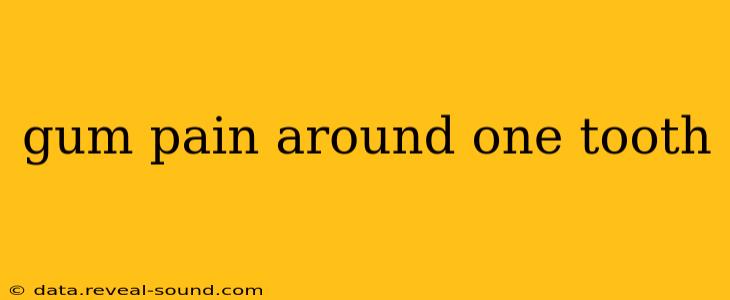Experiencing gum pain localized around a single tooth can be unsettling. This discomfort can range from mild tenderness to sharp, throbbing pain, significantly impacting your daily life. Understanding the potential causes is the first step towards effective management and prevention. This comprehensive guide explores the various reasons behind this type of gum pain, offering insights into diagnosis, treatment, and strategies to maintain healthy gums.
What Causes Gum Pain Around One Tooth?
Several factors can contribute to localized gum pain. Identifying the underlying cause is crucial for appropriate treatment. Common culprits include:
-
Gum disease (gingivitis or periodontitis): Inflammation and infection of the gums are primary causes. Gingivitis, the early stage, is characterized by redness, swelling, and bleeding gums. Periodontitis, a more advanced stage, involves bone and tissue loss around the tooth, leading to increased pain and potential tooth loss.
-
Abscess: A localized pus-filled infection can develop at the root of the tooth or within the gum tissue. Abscesses are often accompanied by severe pain, swelling, and tenderness.
-
Dental caries (cavities): While cavities primarily affect the tooth structure, the resulting inflammation and infection can extend to the surrounding gums, causing pain.
-
Trauma: Injury to the gums, such as from biting your lip or cheek, can result in localized pain and swelling.
-
Food impaction: A piece of food lodged between teeth can irritate the gums, leading to pain and inflammation.
-
Dental procedures: Following dental procedures like extractions, fillings, or deep cleaning, some degree of gum soreness is normal, but excessive or persistent pain warrants attention.
-
Pericoronitis: Inflammation of the gum tissue surrounding a partially erupted tooth, often a wisdom tooth.
-
Medication side effects: Some medications can have gum inflammation as a side effect.
How is Gum Pain Around One Tooth Diagnosed?
A dentist will conduct a thorough examination to diagnose the cause of your gum pain. This typically involves:
- Visual inspection: Examining the gums and teeth for signs of inflammation, swelling, bleeding, or abscesses.
- X-rays: Detecting underlying problems like cavities, bone loss, or impacted teeth.
- Probing: Measuring the depth of the gum pockets to assess the extent of gum disease.
- Palpation: Gently feeling the area to check for tenderness or abnormalities.
What are the Treatments for Gum Pain Around One Tooth?
Treatment will depend on the underlying cause:
-
Gum disease: Professional cleaning, scaling, and root planing to remove plaque and tartar. Antibiotics might be prescribed in cases of infection. In advanced cases, surgical procedures may be necessary.
-
Abscess: Drainage of the abscess and antibiotic treatment are usually required.
-
Cavities: Fillings or other restorative procedures to repair the damaged tooth structure.
-
Trauma: Gentle cleaning, ice packs, and pain relievers can help manage pain and swelling.
-
Food impaction: Removal of the food particle and gentle cleaning of the area.
-
Pericoronitis: Gentle cleaning, antiseptic mouthwash, and possibly surgical removal of the affected gum tissue.
How Can I Prevent Gum Pain Around One Tooth?
Maintaining good oral hygiene is crucial for preventing gum pain. This includes:
- Brushing: Brushing twice daily with fluoride toothpaste for at least two minutes.
- Flossing: Cleaning between teeth daily to remove food particles and plaque.
- Mouthwash: Using an antiseptic mouthwash to help control bacteria.
- Regular dental checkups: Visiting your dentist for regular checkups and professional cleanings.
What Home Remedies Can Help Soothe Gum Pain?
While home remedies can offer temporary relief, they shouldn't replace professional dental care. Some options include:
- Saltwater rinse: Rinsing your mouth with warm salt water can help reduce inflammation and clean the area.
- Cold compress: Applying a cold compress to the affected area can help reduce swelling and pain.
- Over-the-counter pain relievers: Ibuprofen or acetaminophen can help manage pain.
When Should I See a Dentist About Gum Pain?
You should consult a dentist if you experience:
- Severe or persistent gum pain.
- Swelling or redness around a tooth.
- Bleeding gums.
- Pus discharge from the gums.
- Difficulty chewing or opening your mouth.
- Loose teeth.
Addressing gum pain promptly is essential to prevent more serious complications. Regular dental checkups and good oral hygiene practices are your best defense against gum problems. Remember, this information is for educational purposes only and does not constitute medical advice. Always consult a qualified dental professional for diagnosis and treatment.
